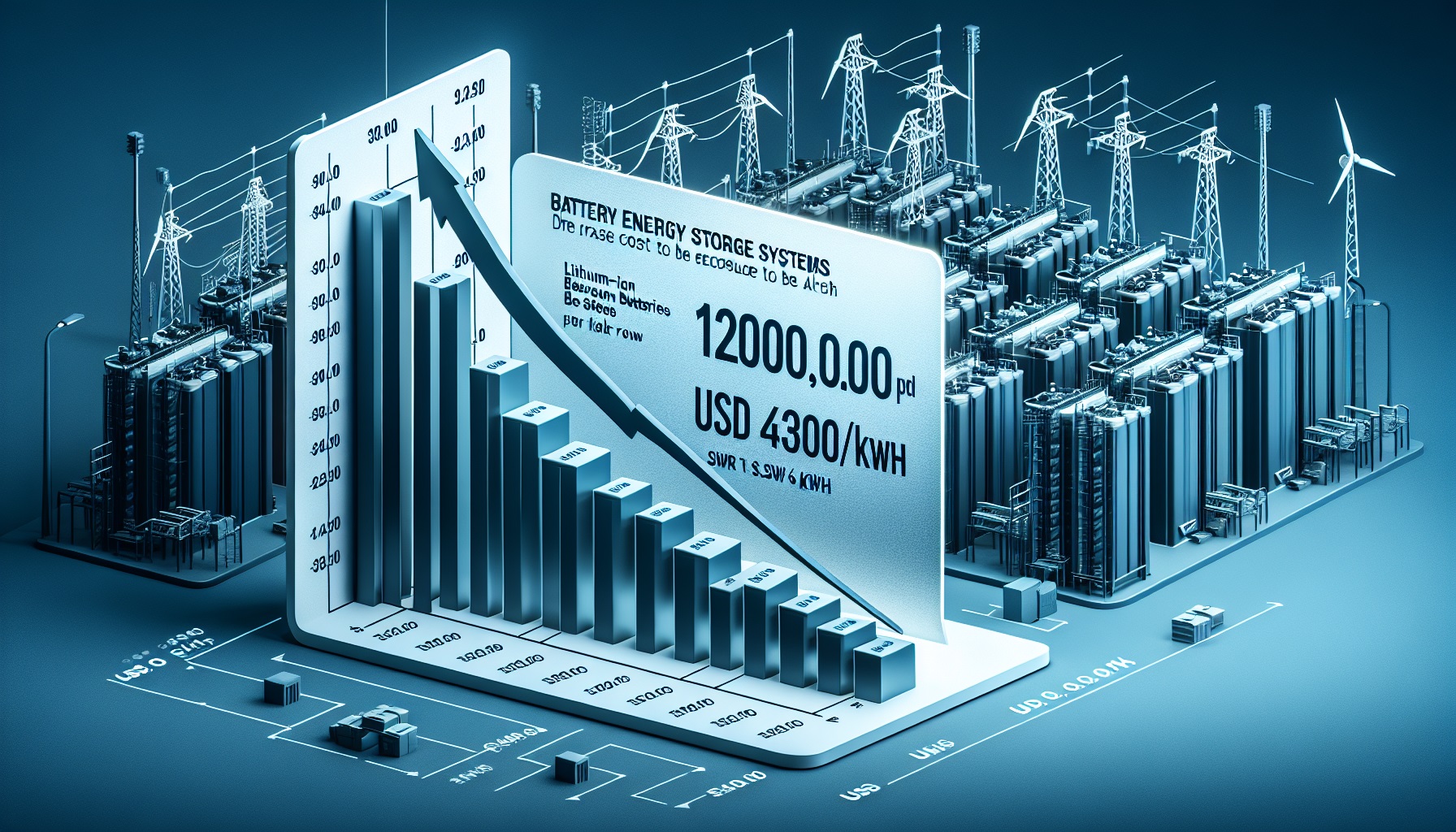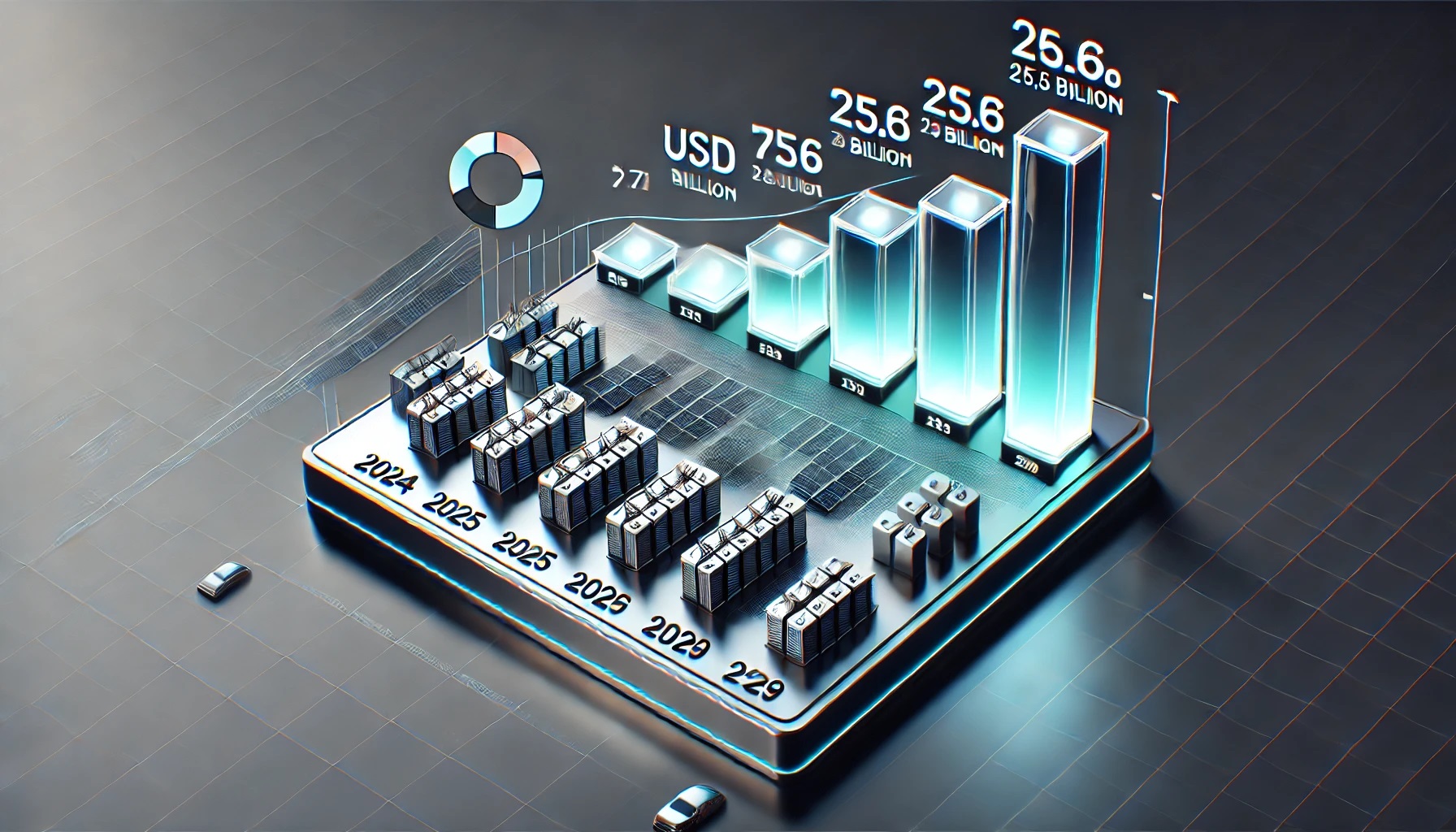The Ultimate Guide to Battery Energy Storage System Market: Powering the Future of Clean Energy
Introduction
The battery energy storage system market is experiencing unprecedented growth, driven by the global push towards clean energy solutions. As countries and industries strive to reduce carbon emissions and increase renewable energy adoption, battery storage has emerged as a critical component in the energy transition. This rapidly expanding market is reshaping the energy landscape, offering solutions to grid stability challenges and enabling the efficient integration of intermittent renewable sources like solar and wind.

The evolution of battery technology has led to significant improvements in energy density, cost-effectiveness, and reliability, making battery energy storage systems more viable for a wide range of applications. From utility-scale installations to residential units, these systems are transforming how energy is generated, distributed, and consumed. The market's growth is further fueled by declining battery costs, supportive government policies, and increasing investments in renewable energy infrastructure. As the industry continues to innovate, the battery energy storage market is poised to play a pivotal role in achieving global sustainability goals and reshaping the future of energy.
The Evolution of Battery Technology in Energy Storage
The journey of battery technology in energy storage has been marked by significant advancements, from the invention of the lead-acid battery to the dominance of lithium-ion batteries in today's market. The lead-acid battery, invented in 1859 by Gaston Planté, was the first rechargeable battery and revolutionized energy storage for its time. However, its limitations in energy density, life cycle, and weight have made it obsolete for modern applications.
The lithium-ion battery, developed in 1979, has become the cornerstone of modern energy storage systems. Its high energy density, long lifespan, and versatility have made it the preferred choice for various applications, from portable electronics to electric vehicles. The significance of this technology was recognized in 2019 when its inventors were awarded the Nobel Prize in Chemistry.
Lithium-ion batteries have seen remarkable cost reductions, with prices dropping by 89% from USD 1200.00 per kilowatt-hour (kWh) in 2010 to USD 132.00/kWh in 2021 . This cost reduction has been crucial in driving the adoption of battery energy storage systems (BESS) across various sectors.
Market Segmentation and Applications
The Battery Energy Storage System (BESS) market is segmented based on connection type, ownership, energy capacity, and application. The market is primarily divided into Front-of-the-Meter (FTM) and Behind-the-Meter (BTM) applications.
Front-of-the-Meter (FTM) Utility-Scale Installations
FTM applications comprise battery storage systems in electric power systems, such as utility-scale generation and energy storage facilities, as well as transmission and distribution lines. These installations, typically larger than 10 megawatt-hours (MWh), are expected to grow around 29% annually for the rest of this decade, reaching 450 to 620 gigawatt-hours (GWh) in annual installations by 2030.
Behind-the-Meter (BTM) Commercial and Industrial
BTM applications include transportation, residential, commercial, and industrial battery storage solutions. The commercial and industrial segment is forecasted to grow at a 13% CAGR, reaching between 52 and 70 GWh in annual additions by 2030. This segment includes electric vehicle charging infrastructure, critical infrastructure, public buildings, and harsh environments.
Residential BESS Solutions
Residential installations, while the smallest segment, are expected to reach about 20 GWh by 2030. These systems enable homeowners to increase self-consumption, optimize energy use, and provide backup power during outages.
Regional Market Analysis
Asia Pacific is the fastest-growing region for the BESS market, driven by rapid economic growth, urbanization, and industrialization. China, Japan, and South Korea are key players, with significant investments in large-scale battery energy storage projects and supportive government policies promoting clean energy adoption.
Growth Driver:
The Battery Energy Storage System (BESS) market is experiencing significant growth, driven by several key factors. These drivers are shaping the future of clean energy and revolutionizing the power sector.
Renewable Energy Integration
BESS plays a crucial role in supporting the integration of renewable energy sources into the grid. As solar and wind power generation increases, BESS helps manage their intermittent nature by storing excess energy for later use. This capability enables a more consistent power supply, reducing waste and supporting a greener grid. The U.S. Energy Information Administration has dramatically increased its 2050 energy storage capacity forecast to 278 gigawatts, a 900% increase from previous projections.
Grid Stability and Reliability
BESS enhances grid stability by rapidly responding to fluctuations in supply and demand. These systems provide quick power injections when needed, preventing voltage sags and blackouts. Additionally, BESS acts as a frequency regulator, maintaining the grid's frequency within acceptable limits. This flexibility allows grid operators to ensure a reliable power supply to consumers.
Energy Cost Reduction
The economic benefits of BESS are significant. These systems can reduce the need for costly grid infrastructure upgrades and improve energy efficiency. In regions such as Germany, North America, and the United Kingdom, where demand charges are often applied, the argument for BESS is particularly strong. The cost of battery storage has fallen rapidly due to economies of scale and technology improvements, making it an increasingly attractive option for energy management.
Government Policies and Incentives
Government support has been instrumental in driving BESS market growth. The Investment Tax Credit (ITC) and Production Tax Credit (PTC) for renewable energy projects have been extended, with the ITC now including qualifying energy storage technology . Additionally, regulatory orders such as Order No. 841 and Order No. 2222 have mandated reforms to optimize the integration and utilization of storage technologies within the grid system . These policies and incentives are fostering a more competitive and dynamic marketplace for BESS.
Challenges and Future Outlook
Technological Advancements
The Battery Energy Storage System (BESS) market faces significant challenges in technological advancement. While lithium-ion batteries currently dominate the market, new technologies are emerging to address existing limitations. These advancements aim to improve specific energy densities, enhance safety, and reduce charging times. For instance, solid-state batteries represent a paradigm shift, offering improved safety and higher energy density compared to conventional lithium-ion batteries.
Supply Chain Considerations
Supply chain management presents a critical challenge for the BESS industry. The concentration of battery cell production, particularly for Lithium Iron Phosphate (LFP) cells, in China has raised concerns about supply chain resilience. North America currently has limited domestic production capacity, with only four operational manufacturing facilities for LFP battery cells. This situation has sparked efforts to regionalize supply chains and reduce dependence on a single source.
Environmental Impact
The environmental implications of BESS are both promising and challenging. On the positive side, energy storage systems enable greater adoption of renewable energy sources, helping to reduce greenhouse gas emissions. However, the industry must address concerns related to the mining of battery materials and end-of-life disposal. The development of cost-effective and efficient battery recycling methods remains in its infancy, posing a potential environmental risk as the number of batteries in the global waste stream increases.
Economic Aspects of BESS
Cost Trends and Projections
The Battery Energy Storage System (BESS) market has witnessed significant cost reductions, making it increasingly attractive for various applications. The cost of purchasing and installing an industrial-scale BESS ranges from USD 450.00 to USD 600.00 per kilowatt-hour (kWh) of capacity.

Notably, lithium-ion battery prices have dropped by 89% from USD 1200.00/kWh in 2010 to USD 132.00/kWh in 2021. Recent projections indicate that average cell prices for stationary storage systems, currently at USD 110.00/kWh, may experience a spike to USD 135.00/kWh in 2025 before stabilizing at USD 117.00/kWh in 2026.
Revenue Models and Profit Pools
BESS operators can generate revenue through various streams, including contracted and merchant revenues. Contracted revenues provide stability through long-term agreements, while merchant revenues offer higher potential profits but with increased market risk. Key revenue models include:
- Tolling Agreements: Operators lease the BESS to an offtaker, receiving steady income while protected from market price variations.
- Energy Arbitrage: Batteries charge when electricity prices are low and discharge when prices are high, generating cost savings and balancing the grid.
- Ancillary Services: BESS can provide frequency regulation, spinning reserves, and voltage support, creating additional revenue streams.
Return on Investment Analysis
The return on investment (ROI) for BESS is influenced by various factors. Internal factors include upfront investment, energy usage patterns, and maintenance costs, while external factors encompass electricity prices, government incentives, and market conditions. Key financial indicators for assessing BESS viability include:
- Total Cost of Ownership (TCO): Comprehensive cost of owning and operating the ESS over its lifecycle.
- Levelized Cost of Storage (LCOS): Average cost per unit of energy stored, considering all lifetime costs.
- Capacity Factor: Ratio of actual energy output to potential output at full capacity.
The Investment Tax Credit (ITC) and Modified Accelerated Cost Recovery System (MACRS) provide significant financial incentives, reducing upfront capital costs and improving overall ROI.
Strategic Considerations for BESS Players
Value Chain Positioning
Companies in the Battery Energy Storage System (BESS) market must carefully consider their position in the value chain. The market spans from raw material extraction to recycling, offering diverse opportunities. For instance, system integrators might explore in-house battery packaging or co-developing new cell chemistries with manufacturers. Battery manufacturers could expand into system integration or service capabilities to target specific segments like utilities.
Technology Adoption Strategies
BESS players need to stay abreast of technological advancements. While lithium-ion batteries currently dominate, emerging technologies like sodium-ion batteries show promise. Sodium-ion batteries, despite lower cycle life and energy density, offer potential cost savings of up to 20% compared to lithium iron phosphate (LFP) batteries. Companies must decide which technologies to invest in and how to prepare for transitions, such as integrators setting up systems for easy adoption of sodium-ion batteries.
Partnerships and Collaborations
Partnerships are crucial in the rapidly evolving BESS market. The industry has seen 43 material partnership announcements in the last three years alone. These collaborations span various stages of the value chain and involve diverse players, including competitors, automakers, battery suppliers, governments, and research institutions. For example, Volkswagen partnered with battery cell maker Northvolt, while Tesla formed a joint venture with Panasonic to build a 'gigafactory'. Such strategic alliances can help companies navigate technological uncertainties, share risks, and accelerate innovation in the BESS sector.
The Role of BESS in the Clean Energy Transition
Battery Energy Storage Systems (BESS) play a crucial role in the transition to clean energy by addressing key challenges in renewable energy integration and grid stability. These systems offer versatile solutions for balancing intermittent renewable sources, managing peak demand, and providing essential ancillary services.

Balancing Intermittent Renewable Sources
BESS helps smooth out fluctuations in wind and solar power output, enhancing grid stability and reliability. By storing excess energy during high production periods and releasing it when needed, BESS ensures a more consistent power supply. This capability has been shown to increase energy efficiency by up to 35% in wind farms.
Peak Shaving and Load Shifting
BESS enables peak shaving by reducing electricity consumption during high demand periods. This strategy eliminates short-term demand spikes and lowers overall electricity costs. Energy storage systems charge during off-peak hours and discharge during peak times, effectively balancing electricity supply and demand.
Ancillary Services for Grid Stability
BESS provides critical ancillary services such as frequency regulation and voltage support. These fast-response capabilities help maintain grid stability and improve overall network performance. The quick ramp rate of storage systems allows them to offer double the regulatory benefit of conventional generators, reducing wear on other generation assets.
Global Market Landscape
The battery energy storage system (BESS) market is experiencing rapid growth globally. In 2023, the market nearly tripled, marking the largest year-on-year increase on record. Projections indicate that the global BESS market will reach USD 25.6 billion by 2029, growing at a CAGR of 26.9% from USD 7.8 billion in 2024.

Leading Countries and Regions
The United States, China, and the United Kingdom are currently the most attractive investment markets for BESS. China, ranking second, has implemented strong state subsidies and aims to reduce BESS construction costs by 30% by 2025. The Asia Pacific region dominates the market, holding a 45.16% market share in 2021.
Key Players and Market Share
Major players in the BESS market include BYD Company Ltd, Samsung SDI Co., Ltd., LG Energy Solutions, and Panasonic Corporation. Other significant companies include Tesla, GE Vernova, Hitachi Energy Ltd., and Siemens Energy. These manufacturers are driving innovation and competition in the industry.
Investment Trends and Funding
The global energy storage industry saw a significant increase in corporate funding, reaching USD 11.70 billion in the first quarter of 2024, a 432% increase from the previous year. Notably, two battery manufacturers, Northvolt and Automotive Cells Company, secured multi-billion dollar debt financing deals, accounting for 83% of the total raised funds. This surge in investment reflects the growing recognition of energy storage as a key component in the clean energy transition.
Technological Innovations Driving BESS Growth
Advanced Battery Management Systems
The Advanced Battery Management System (ABMS) plays a crucial role in optimizing Battery Energy Storage System (BESS) performance. Implemented in cloud servers, ABMS benefits from increased computational resources, enabling the development of complex storage system models. This innovation helps detect potential BMS failures and aggregates monitoring data from different BMS units, achieving better battery state estimations. The BMS ensures optimal charge levels, prolongs system lifecycle, and monitors internal performance of battery cells.
Integration with AI and IoT
Internet of Things (IoT) technology is revolutionizing BESS operations. IoT solutions facilitate real-time monitoring and control, optimizing efficiency, security, and resilience. For instance, in HVAC control, IoT enables temperature data acquisition and alarm detection through analog inputs and digital outputs. Companies like Advantech provide IoT-ready BESS solutions, incorporating edge-to-cloud technology for efficient electricity use in industrial settings.
Scalability and Modularity Advancements
Modular designs are enhancing BESS scalability, particularly for grid-scale applications. These designs allow flexible scaling of storage capacity to meet evolving energy demands. Innovative modular architectures, such as trailer-mobile battery storage units, offer high flexibility and scalability. For example, a single Power Conversion System (PCS) unit can be coupled with multiple battery system units, allowing projects to grow as needed. This approach facilitates easier maintenance, upgrades, and repurposing of battery assets, ensuring long-term viability and return on investment.
BESS Applications Across Sectors
Utility and Grid Operations
Battery Energy Storage Systems (BESS) play a crucial role in utility-scale operations, with installations typically larger than 10 megawatt-hours (MWh). These systems are projected to grow at an impressive rate of 29% annually, reaching 450 to 620 gigawatt-hours (GWh) in annual installations by 2030. Utilities, grid operators, and renewable developers utilize BESS to balance intermittent renewable energy sources, provide grid stability services, and defer costly grid investments. BESS enhances grid resilience by offering fast-response frequency regulation and spinning reserve capabilities.
Commercial and Industrial Use Cases
The commercial and industrial (C&I) segment is expected to grow at a 13% CAGR, reaching 52 to 70 GWh in annual additions by 2030. Key applications include:
- Electric vehicle charging infrastructure
- Critical infrastructure (e.g., telecommunication towers, data centers, hospitals)
- Public buildings and factories
- Harsh environments (mining, construction, outdoor events)
BESS enables peak shaving, renewable energy integration, and energy cost reduction of up to 80% in some cases. Companies like Exro Technologies offer solutions such as the Cell Driver™ system for efficient commercial energy management.
Residential and Community Energy Storage
Residential BESS installations, while smaller, are projected to reach about 20 GWh by 2030. These systems allow homeowners to optimize self-consumption, manage peak demand, and integrate with rooftop solar installations. Community energy storage, although not precisely defined, can encompass various configurations, including:
- Utility-operated distribution feeder systems
- Aggregated behind-the-meter batteries in a geographic community
- In-front-of-meter systems serving local customers
- Single-meter systems for large campuses or military bases
As the BESS market evolves, regulators and stakeholders will need to address policy frameworks to facilitate widespread adoption and equitable distribution of benefits.
Future Trends and Innovations
Next-Generation Battery Technologies
The battery energy storage system (BESS) market is evolving rapidly, with advancements in lithium-ion technology and the emergence of new alternatives. Researchers are developing high-capacity nickel-rich cathode materials to boost capacity and longevity. MIT chemists have created an organic battery using bis-tetraaminobenzoquinone, offering a more sustainable alternative to traditional metal-based cathodes. Additionally, sodium-ion batteries are gaining traction, potentially offering up to 20% cost savings compared to lithium iron phosphate batteries.
Integration with Renewable Energy Systems
Innovative energy storage solutions are enhancing renewable energy integration. Green Gravity, an Australian start-up, is utilizing gravitational potential energy in disused mine shafts to store excess renewable power. Finland's Polar Night Energy has developed a sand-based thermal battery capable of storing 8 megawatt-hours of energy and supporting heating for approximately 100 homes. These advancements facilitate load shifting and renewable generation smoothing, crucial for grid stability.
Vehicle-to-Grid (V2G) Technology
V2G technology is poised to revolutionize energy management by enabling bidirectional power flow between electric vehicles and the grid. This innovation allows EVs to serve as mobile energy storage units, potentially meeting short-term energy storage demands by 2030. V2G systems can help balance electricity demand, reduce grid congestion, and generate additional revenue for fleet operators and individual EV owners. One study found that a single V2G charger could save up to USD 1900.00 annually in utility bills.
FAQs
-
What are the growth projections for the battery energy storage systems market?
The Battery Energy Storage Systems (BESS) market is expected to expand significantly, from USD 7.8 billion in 2024 to USD 25.6 billion by 2029. This growth is projected at a compound annual growth rate (CAGR) of 26.9% during the forecast period from 2024 to 2029.
-
What are the main disadvantages of battery storage systems?
One significant drawback of battery storage systems is the cost associated with replacement and maintenance. Batteries have a limited lifespan and will need to be replaced over time, which adds to the long-term expenses of any solar energy storage system. Additionally, regular maintenance is necessary to maintain optimal performance and extend the battery's life, further incurring ongoing costs.
-
How long do battery energy storage systems typically last?
Battery energy storage systems generally have a lifespan ranging from 5 to 15 years.
Related Reports:
Battery Energy Storage System Market by Battery Type (Lithium-ion, Advanced Lead Acid, Flow, Nickel-based), Energy Capacity (Below 100 MWh, Between 100 MWh & 500 MWh, Above 500 MWh), Connection Type, Ownership and Region - Global Forecast to 2029
Contact:
Mr. Rohan Salgarkar
MarketsandMarkets™ INC.
1615 South Congress Ave.
Suite 103
Delray Beach, FL 33445
USA : 1-888-600-6441
sales@marketsandmarkets.com
This FREE sample includes market data points, ranging from trend analyses to market estimates & forecasts. See for yourself.
SEND ME A FREE SAMPLE





